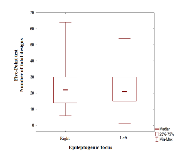Performance of Patients With Temporal Lobe Epilepsy in Test of Executive Function
Abstract number :
3.381
Submission category :
11. Behavior/Neuropsychology/Language / 11A. Adult
Year :
2018
Submission ID :
501861
Source :
www.aesnet.org
Presentation date :
12/3/2018 1:55:12 PM
Published date :
Nov 5, 2018, 18:00 PM
Authors :
Paula T. Marques, Hospital de Clínicas da UFPR; Luiza Muller, Hospital de Clínicas da UFPR; Maria Joana Mader-Joaquim, Hospital de Clínicas da UFPR; Vera Cristina Terra, Hospital de Clínicas da UFPR; Luciano de Paola, Hospital de Cl�
Rationale: The Five-Point Test (FP) is used as a screening tool for the evaluation of executive functions (EF), in order to measure the ability to initiate and sustain mental productivity and levels of self-monitoring in the visuospatial domain. Although widely used, studies on psychometric characteristics and normative data are lacking in the national literature, especially in patients with epilepsy. The aim of this research is to investigate and update data on the performance profile of patients with unilateral temporal lobe epilepsy in the FP test. Methods: The longitudinal observational study consisted of a study group (SG) and a control group (CG). 180 patients between 18 and 65 years of age, of both sexes, with at least 2 years of complete schooling and with diagnosis of refractory unilateral temporal lobe epilepsy confirmed by recording of seizures by Video Electroencephalogram and presence of mesial temporal sclerosis by 3-Tesla magnetic resonance composed the SG. The CG sample consisted of 150 healthy individuals with the same characteristics in relation to gender, age and schooling. A convenience sample was used at a public hospital in the city of Curitiba (PR). All participants were submitted to the FP test. The Student's T test was used to compare the two independent samples, applying the normality test between groups. Results: The comparison between the SG and the CG showed no statistical difference in the analyzed variables, except for the level of schooling, indicating that the groups are comparable to each other. A significant statistical difference (p = 0.0001) was found in the FP test performance between the groups regarding the total number of designs, indicating better CG performance. The comparison of the scores in the FP test between the SG of patients with left and right epileptogenic focus did not show statistical difference between these groups (p = 0.479). Conclusions: The results suggest that patients with epilepsy present worse performance in the evaluation of EF when compared with healthy individuals. Despite the greater involvement of frontal areas in tasks of EF, there may also be involvement of temporal lobes, in order to justify the worse results obtained in the SG when compared with the CG. Despite the correlation of the FP test and regions in the right hemisphere, the results do not suggest differences between the group of patients with right and left epileptogenic focus. These findings update the variables that contribute to the performance in the FP test, providing new parameters regarding the use of this instrument in the neuropsychological evaluation of EF in adults, especially in the population with epilepsy. Funding: No funding
